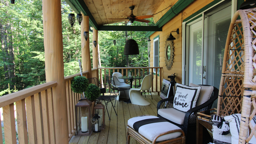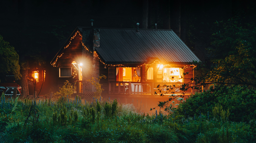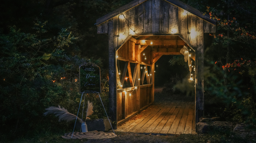
Cabin life and boating fun go hand in hand, but shopping for a vessel can feel foreign and, frankly, confusing. If you’re ready to take your boating experience beyond the canoe, we’ve tapped our resident expert, Dan Harding, editor-in-chief of Power & MotorYacht magazine, for advice. The following is an excerpt from a piece he wrote about how to shop a boat show. For additional boating info, visit powerandmotoryacht.com or anglersjournal.com.
Whether you’re shopping for a passagemaker to travel the world or hunting for a smaller center-console to fish with the family, odds are you’ll be able to find what you’re looking for at a boat show. To help you in your search we’ve assembled an advisory board comprised of industry experts to provide insider advice on what to look for — and avoid — in the buying process.
Down East Boats
If you’re even remotely considering the purchase of a Down East yacht, you’re going to want to know about the new design trends in that segment, and who better to explain these shifts than Doug Zurn, founder of Zurn Yacht Design? The firm boasts a long client list that includes such groundbreaking names as MJM Yachts, Marlow Yachts, Shelter Island Runabouts, not to mention his own Zurn yachts. We chased down Doug to get his insights.
What are some new demands you’re seeing from clients?
Today’s boats need to have performance and economy. Those are two things that weren’t required as much on older boats. They need to have a certain amount of function so they can entertain a lot of people and accommodations for two and maybe the occasional guest. I often hear, “We like having people aboard, but we don’t encourage them to stay the night” [laughs].
Access to the water is also important, whether that’s via a transom door, swim platform or retractable swim platforms. And I think open-concept layouts for sure. Our houses have gone “open concept,” and now our boats have, too. We’re returning to the mentality of, “Hey we’re on the water, let’s enjoy it.” We don’t need to be encapsulated in a small cabin.
But I’d say the biggest demand is definitely comfort and performance, those are the two big things that have kept us the busiest the last few years. We’re building boats that are fast, comfortable and dry in all sea states.
What advice do you have for someone walking a show in search of a Down East boat?
My advice would be to pay attention to the details of the design. Ask how people use the boats. Understand how you’re going to use it yourself. Some people buy boats to live on at the dock, some people want to go places — those boat types are available in the Down East range.
Also, keep resale in mind. How do the boats do on the resale market? Because, eventually you’re going to want something new or better. I find that with a lot of our boats, they initially seem expensive, but at the end of the day, after you’ve spent the money on fuel, enjoyed your time on the water and the places you’ve gone and you have all those memories, you’re going to want to know your return on investment.
And don’t buy a boat without taking it through its paces. If there is no opportunity on a trial to hit waves, then run in a circle until you make your own. Is the boat quiet when running? That’s important to know.
Has the demographic of buyers changed in recent years?
We’ve seen a shift to younger buyers. There are a lot of people in their mid-40s. I think that’s because they outgrow their center consoles and they want a little more protection, but they still want the fun of a center console, which is generally known as a good sea boat. Down East boats also have a seaworthy heritage, coming from fishing boats. So, while the two types of boats are different, they do share some common ground. That’s why we’re attracting so many center console owners.

Passagemaking Boats
From his experience in the commercial fishing industry, to his time in the Merchant Marines, Jeff Druek’s (president and CEO of Outer Reef Yachts) expertise is varied and extensive, which makes his advice valuable.
What are today’s must-haves for passagemakers?
The purchasers of passagemakers are, in general, much more focused on their choices and requirements as it pertains to their long-range cruising lifestyle. The very nature of extended cruising equates to being aboard for long periods of time. Cruising independence is highly valued, as well as the need for more destination anchoring, which requires larger house battery banks with inverters and solar panels for spending time at anchorages. Additionally, other important considerations are fuel capacity and range at hull speeds, along with stability and redundancy of critical equipment built in during construction. Comfortable and spacious accommodations, in conjunction with substantial stowage areas and ease of maintenance, are also key elements.
What are some considerations boaters should make when looking at a boat to buy?
There may be nothing more critical than the consideration of retention of value, high-quality construction and after-delivery service and support. Retention of value or retained equity value after three to five years of cruising is most often found when builders have limited or no inventory builds; no extra profit dealer networks; calculated, limited and beneficial styling changes; and quality after-sales service.
Are there any design trends you see coming?
The most notable is a significant upgrade in sophistication of operation systems. Also, popular and frequent options are hardtops, bow and stern thrusters, remote controls or joystick operation; and it’s important to note that more owners are glad not to have the extra maintenance of exterior teak. All of these improvements in technology and design have created a more enjoyable experience for the owner, who is the best source of ideas for continued build improvements.
Sportfishing Boats
While his official title is communications director for Viking Yachts, Peter Frederiksen also holds the honorary title of boat-show expert, what with a couple hundred boat shows under his gimbal belt. He offers sound advice for folks shopping a boat show.
What type of homework should a buyer do?
When shopping for a new boat, take the time to study the brand. Look at a lot of them and from all ages. It’s a clue to how well the boat holds up, as well as a means to see what changes have evolved.
What advice do you have for someone shopping for a sportfisherman at a boat show?
Clarify your position; are you looking to see what’s available, or planning to buy? Boats on display will have show prices — usually with a time constraint. After the show, the price may change, or if it is a “Boat Show Special” it may be specially equipped with accessories or optional equipment and be one of a kind. Once that boat goes away, a similar replacement may cost more because of raw material increases or price increases in general due to different engines, other accessories or model-year change.
What considerations should boaters make when walking through a boat they might buy?
When you are looking over a boat, know what you are looking at. Take livewells, for instance. A gallon of water weighs 8 pounds. If the well is installed on centerline, it will be less likely to affect the boat’s trim and stability when you’re locked and loaded to go fishing. Look around for safety items including grabrails, nonslip walking areas and ample freeboard. Rounded corners and coamings prevent bruises. All boats have tackle stowage, but you don’t want it to be a haphazard design where hooks and swivels fall out on the deck every time the door swings open because the boat is pounding into waves. Locking hardware is more expensive but worth it!
Also, check the visibility from the helm. Will your electronics be safe or blessed with a saltwater baptism every time the wind blows 10 knots? The single most expensive item on the boat will be its engine(s), and larger engines are usually preferred, especially at resale time. Are they accessible for maintenance and service? Is the boat fully equipped and scheduled to be delivered turnkey ready, or will you have to spend more money and time outfitting it? Factor your time and the value of your time when calculating this number because installing after-market equipment requires disassembling parts of the boat to affect a good job.
What should buyers know about the purchasing process?
When speaking with a dealership salesperson, also seek out a manufacturer’s rep if one is available. He or she will have the ability to answer all your questions about availability, power suggestions, optional equipment, etc. Availability is key. People who build a new boat typically order them in the fall for delivery in the coming summer. At the winter boat shows, the current inventory is on display. Model year generally changes in June. Depending upon the manufacturer’s backlog, there may not be a slot available if you delay making a commitment and fail to sign a contract. If you have a trade, be honest about its condition and the engine hours. Some would-be buyers try to bargain for a wholesale price for the new boat yet think their trade is worth retail. It does not work that way. Remember, the dealer has to sell your boat, too! Finally, read your contract completely and pose any questions you have or expect to have.
Boat Breakdown
With so many models on the market, how do you know which one is right for you? Use this overview to help you start your boat-buying search.
Bowrider
Often an entry-level boat, new enthusiasts and seasoned captains alike love the versatile bowrider. Ideal for day cruising and watersports. Typically 16 to 28 feet long.
- Deck Boat: Just as the name implies, this model has a lot of deck space, which makes it perfect for afternoons lounging on the lake with a handful of friends. Perfect for day cruising and water sports. Typically 18 to 25 feet long.
- High-Performance Boat: Want to go fast … like really fast? This is the powerboat for you, but be prepared for sticker shock — most new models start at six figures and it’s not designed to carry a large number of passengers. However, the speed will live up to its name. Typically 16 to 50 feet long.
- Walkarounds: With a small cabin and easy access from bow to stern, these boats range from basic to luxurious. Perfect for saltwater fishing and day cruising. Typically 18 to 30 feet long.
How do you find the right boat for your budget?
When Jack Robertson walks the docks, he carries with him 29 years of experience in the marine industry, 17 of them spent pairing up boaters with the right vessel as a broker for HMY. So we asked him: How do you help a new boater find the right boat?
“There are only 52 weekends in a year; so I ask them, ‘How many of those are you going to spend on the boat?’ Because what happens is someone comes to a show to see a 50-footer and they finish the day looking at a boat up to 100 feet and then they ask, ‘Why did we spend the whole day looking at boats we can’t afford?’
“Understand how you’re going to use a boat. And then start the process by looking at a name-brand boat so you have a basis. For example, if you wanted a sportfish, I would start with Viking first to set a benchmark and work my way to more affordable options. Then you’ll have a better understanding of costs.”
Every boat needs the perfect dock. But should you hire a pro builder or go the DIY route? Explore your options here!







_11868_2023-11-27_14-56-1280x720.png)







